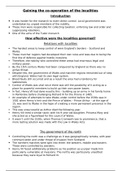Gaining the co-operation of the localities
Introduction
It was harder for the monarch to exert direct control. Local government was
undertaken by unpaid members of the nobility.
These men were responsible for collecting taxation, enforcing law and order and
suppressing rebellions.
One of the aims of the Tudor monarch
How effective were the localities governed?
Relations with localities
The hardest areas to keep control of were England's borders – Scotland and
Wales.
These marcher regions had developed their own rules and laws due to being the
first line of defence against hostile invasions.
Therefore, the nobility who controlled these areas had enormous legal and
military power.
By the 15th century Wales had been conquered by England so there was no
active threat.
Despite this, the government of Wales and marcher regions remained out of step
with England. Wales had its own legal system.
Blood feuds still occurred and as a result the area had a tendency for
lawlessness
Control of Wales was vital since there was still the possibility of it acting as a
place for powerful members to build up their own power bases.
In fact, Henry VII had done exactly this – building up an army in his family home
in Pembroke before challenging Richard III for the throne in 1485.
An example of attempts to take Wales under control before the 1530s was in
1501 when Henry’s heir and the Prince of Wales – Prince Arthur – at the age of
15, was sent to Wales in the hope of creating a more permanent presence in the
region.
This was unsuccessful as Arthur died the following year.
Henry VIII tried a similar tactic with his 9 year old daughter, Princess Mary and
she acted as a figurehead for the council of Wales.
It wasn’t until the 1530s, when Thomas Cromwell rose to prominence, that a
more lasting solution was made with the Law in Wales Acts.
The government of the north
Controlling the north was a challenge as it was geographically remote, with poor
communication and under threat of invasion from Scotland.
The northern marches were split into three: the western, middle and eastern.
These were controlled by wardens.
Henry VII faced additionally problems as his position as usurper made him
particularly vulnerable at invasions. The norths was particularly unsettled
because they were loyal to Richard III.
, The north suffered from economic hardship in 1489, there was a tax revolt in
Yorkshire which led to the murder of Henry Percy, Earl of Northumberland.
Under Henry VIII the key noble families were the Dacres, the Clifford’s, the Percy
and the Neville’s. These families were involved in complex feuds and could not
always be relied on to keep the peace.
It was not until the pilgrimage of grace, that royal intervention in the
government of the north became more direct and permanent
The law in wales Act (1535)
Cromwell appointed Rowland Lee to act as the Lord President of the council of
Wales.
In 1535, Cromwell introduced the first Law in Wales Act, which was passed in
parliament in 1536. The act transformed the structure of the welsh government:
o The principality of wales was replaced by 12 English style counties.
o The English- style system of local government was introduced.
o Banned the use of Welsh in courts- only English was to be spoken.
o Welsh MPs were elected to sit in English parliament.
The main result of the Act was the end of the Traditional military power of the
marcher lords
The law in wales Act (1542)
In 1542, a second Law in Wales Act was introduced, which was built on the 1535
Act.
In order to enforce English law, a new system of law courts was introduced called
the courts of great sessions. These were held twice a year.
The Act also reorganised the Council of the Marches, which was now known was
the council of Wales.
The council of wales became a more formal body, with a president and a vice
president who were appointed by the monarchs.
By Elizabeth’s reign, the Marcher Council had adapted further to include the Lord
Lieutenant.
The reforms of the 1530s extended very successfully the power of the Tudor
Monarchs into a region which had previously been problematic.
The re- establishment of the council of the north, 1537
Henry’s inability to control the North meant that threat of political instability
became clear in 1536
1536 rebellion broke out in Lincolnshire and spread northwards
As a result Thomas Cromwell decided to remodel the council in 1537 to
strengthen its powers and prevent future outbreaks
It became the voice of government in London
Responsible for passing on and enforcing royal proclamations and orders made
to Sheriffs and JPs
Cromwell extended the authority of the Council so they governed Yorkshire as
well as Durham, Northumberland, Cumberland and Westmorland





